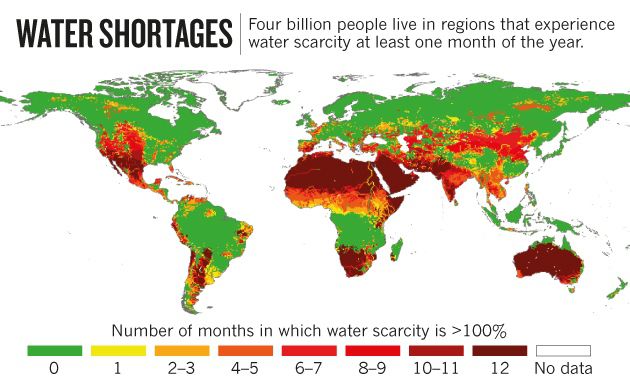4 Billion People Cannot Access Enough Water to Meet Their Basic Needs
Published on by Water Network Research, Official research team of The Water Network in Academic
Four billion people do not have enough water to meet their basic needs. That is far greater than previously understood, according to a new study that presents a more accurate picture of the problem
Water scarcity is fueled by population growth, consumption habits and demands from agriculture.
Previous studies estimated that between 1.7 billion and 3.1 billion people are affected by severe water scarcity, but those findings were based on annual data that failed to capture variations in consumption and supply throughout the year. In the paper published today, researchers used monthly data on freshwater consumption and supply to evaluate water scarcity from 1996 to 2005, accounting for agriculture, municipal use, and environmental needs. Of the 4 billion people facing severe water scarcity at least one month a year 130 million live in the US — mostly in California, Texas, and Florida. Other affected countries include Bangladesh (130 million people), Pakistan (120 million), and Nigeria (110 million).
Everyone won’t suffer equally as in the developed richer countries severe water shortages may indicate water rations for showering and gardening, whereas in very poor nations it could result into drinking water scarcity.
Along with well-known dry places such as Australia and the Middle East, the map identifies parts of Africa and Mexico, southern Europe, Turkey, Central Asia and northern China as places where periods of water scarcity may cause local hardship — but might also trigger problems that extend beyond the places and times where fresh water is in short supply. For example, many of Europe’s imports of food and other goods rely on reliable water in China, Hoekstra notes.
Unlike previous studies, this work compares consumption to available water on a monthly rather than annual basis from around the world. In their models, researchers included data on climate, land use, soils, crop growth, irrigation, population densities and industry.
Water scarcity widespread
The study finds that the situation affects many more than the 1.7 to 3 billion people previously estimated. China and India account for approximately half of the four billion reported in the study. Hoekstra said the problem is widespread, with critical shortages also in Mexico, North Africa, South Africa, the Middle East and the American West.
“We have a much more accurate picture from all those places,” he said. “The data shows us precisely when the scarcity occurs and for what reason.”
Hoekstra said the study creates a new baseline for policymakers
“Governments need to set a water cap for every month so they don’t allow more water use than water available, and people must become more aware of how much water is being used for everything they consume,” Hoekstra said.
Consumer awareness also helps, he added, explaining, “Consumers can make choices based on the amount of water used for making their products. And if they consume less meat, for example, it will really save a lot of water.”
Sustainable use crucial
Hoekstra said the key is to use water more sustainably, a mandate that ranks high on the international agenda.
“The World Economic Forum names water scarcity — together with climate change — as the highest priority of environmental concern. It is the biggest risk to the global economy,” he said.
Hoekstra adds that governments should put a price on water resources and allocate those resources more wisely.
He hopes the new data will lead to action to reduce water scarcity, taking into account how to use water more efficiently, how to consume water more sustainably and how, by changing our habits as consumers, we can make a real difference.
How do you deal with a planet that’s running out of fresh water?
The scientists argue we need better accounting of water resources, enabling governments to manage what they have. Technology will play a role, too, ensuring that we used water more efficiently in agriculture and other industries. And people will start paying attention to how water is used along supply chains. Soon, we’ll demand that our consumer goods are not only fair trade and cruelty-free, but low-water, too.
Source: Daily Albany Star
Read More Related Content On This Topic - Click Here
Media
Taxonomy
- Crisis
- Water Supply
- Drinking Water